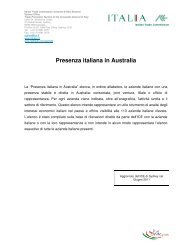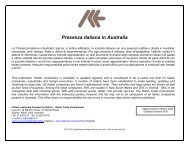Price Determination in the Australian Food Industry A Report
Price Determination in the Australian Food Industry A Report
Price Determination in the Australian Food Industry A Report
You also want an ePaper? Increase the reach of your titles
YUMPU automatically turns print PDFs into web optimized ePapers that Google loves.
Over time <strong>the</strong> cost of terms (<strong>in</strong> terms of <strong>the</strong> rate per dollar) has <strong>in</strong>creased across food categories,<br />
as retailers have sought greater fund<strong>in</strong>g and promotional support to drive <strong>in</strong>creased volumes<br />
through <strong>the</strong>ir expand<strong>in</strong>g bus<strong>in</strong>esses. For example, suppliers devote market<strong>in</strong>g funds to po<strong>in</strong>t-ofsale<br />
activities. The ability of retailers through <strong>the</strong>ir performance to earn a greater share of <strong>the</strong><br />
manufacturers’ available terms is crucial to be<strong>in</strong>g competitive with <strong>the</strong>ir market offer.<br />
Use of <strong>the</strong> private label<br />
The private label is now a major tool <strong>in</strong> <strong>the</strong> category management strategy of all major retailers,<br />
<strong>in</strong>clud<strong>in</strong>g <strong>the</strong> major groups <strong>in</strong> <strong>the</strong> <strong>Australian</strong> <strong>in</strong>dustry. The private label is used primarily to provide<br />
a price-competitive weapon that is essentially used <strong>in</strong> key commodity l<strong>in</strong>es. There are however<br />
some different uses <strong>in</strong> <strong>the</strong> position<strong>in</strong>g of <strong>the</strong> private label between <strong>the</strong> major cha<strong>in</strong>s.<br />
The private label is <strong>the</strong>re to provide <strong>the</strong> customer with an option and to provide preferred<br />
suppliers with volume sales outlets. It is used by many small suppliers to ga<strong>in</strong> a national market<br />
for <strong>the</strong>ir products and improve scale production capability and reduce overhead costs. The private<br />
label is used selectively to add to a category performance for <strong>the</strong> retailer.<br />
The approach will vary accord<strong>in</strong>g to:<br />
• perceived consumer loyalty to major supplier proprietary brands;<br />
• categories where strong potential exists to capture market share for <strong>the</strong> retailer (such as, eggs,<br />
packaged milk) as <strong>the</strong>y are commodity products with low consumer <strong>in</strong>volvement or excitement;<br />
and<br />
• scope to assist with cost reduction <strong>in</strong> some products where adjustment is occurr<strong>in</strong>g.<br />
Private label products are exclusive to each retailer and provide a chance to build loyalty and trust.<br />
The pric<strong>in</strong>g strategy used for private label products varies from category to category, though <strong>the</strong>se<br />
products are generally priced below proprietary branded equivalent items which <strong>in</strong> many cases are<br />
of little or no difference <strong>in</strong> product quality. The role of private label l<strong>in</strong>es <strong>in</strong> category management<br />
is a case by case situation and sweep<strong>in</strong>g assertions regard<strong>in</strong>g <strong>the</strong> tactics used with such l<strong>in</strong>es run<br />
<strong>the</strong> risk of be<strong>in</strong>g oversimplistic.<br />
Specials versus every day low prices<br />
Retailers use price as <strong>the</strong> major competitive weapon. It has conventionally been used to drive<br />
market share ma<strong>in</strong>tenance and growth <strong>in</strong> a category through periodic discount<strong>in</strong>g or ‘speciall<strong>in</strong>g’<br />
which is funded through price support by <strong>the</strong> supplier and retailer accord<strong>in</strong>g to a promotional<br />
program.<br />
Major retailers have recently moved to a strategy of consistent lower prices on key l<strong>in</strong>es – each<br />
retailer promot<strong>in</strong>g <strong>the</strong> concept to <strong>the</strong> consumer as a different <strong>the</strong>me but essentially <strong>the</strong> concepts<br />
are <strong>the</strong> same.<br />
Woolworths promotes ‘every day low prices’ while Coles refers to ‘save everyday’ on <strong>the</strong> same<br />
pr<strong>in</strong>ciples. Under <strong>the</strong>se approaches prices have been ‘rolled back’ to provide lower retail prices<br />
whilst ma<strong>in</strong>ta<strong>in</strong><strong>in</strong>g a target marg<strong>in</strong> to <strong>the</strong> retailer <strong>in</strong> l<strong>in</strong>e with plan. Whilst this has reduced prices<br />
available to <strong>the</strong> supplier and <strong>the</strong>ir cost of do<strong>in</strong>g bus<strong>in</strong>ess (which <strong>the</strong> supplier offers to <strong>the</strong> retail<br />
buyer), it also provides reliable sales volumes of commodity l<strong>in</strong>es.<br />
The role of food service<br />
In 2001, <strong>the</strong> food service sector represented 31 per cent of food sales <strong>in</strong> <strong>the</strong> <strong>Australian</strong> market. It is<br />
projected to slowly grow to 35 per cent by <strong>the</strong> end of <strong>the</strong> decade (BIS Shrapnel 2002). Data fur<strong>the</strong>r<br />
suggests that food service is grow<strong>in</strong>g at a faster rate than total grocery food sales with <strong>the</strong><br />
expansion of <strong>the</strong> quick service restaurant format, <strong>the</strong> growth <strong>in</strong> <strong>the</strong> hospitality sector and <strong>the</strong><br />
development of large <strong>in</strong>tegrated food service distributors to specifically service <strong>the</strong> needs of food<br />
outlets. Total food service grew by 31 per cent <strong>in</strong> <strong>the</strong> five years to 2001 (BIS Shrapnel 2002).<br />
<strong>Price</strong> <strong>Determ<strong>in</strong>ation</strong> <strong>in</strong> <strong>the</strong> <strong>Australian</strong> <strong>Food</strong> <strong>Industry</strong> A <strong>Report</strong><br />
117







